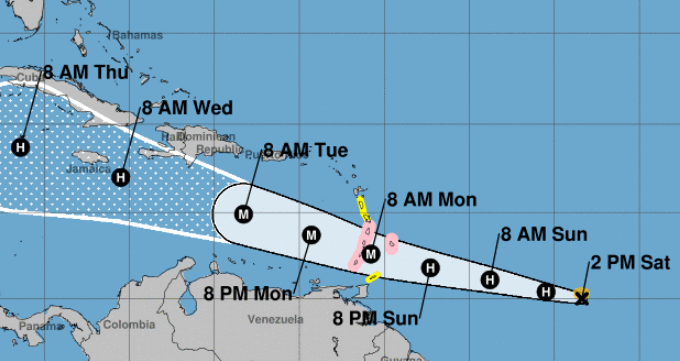Tropical Storm Beryl is forecast to become a “dangerous major hurricane” with top winds of 115 mph as it crosses the Caribbean Sea, according to the 11 a.m. Saturday update from the National Hurricane Center.
The hurricane center revised its forecast of the hurricane’s strength sharply upward Saturday, saying the storm’s structure has become more compact and it will likely “have an opportunity to rapidly intensify given the low wind shear conditions.”
“Beryl is expected to rapidly strengthen and be a major hurricane when it reaches the Windward Islands late Sunday night or Monday, bringing destructive hurricane-force winds and life-threatening storm surge,” the hurricane center said.
Hurricane watches went up across the eastern Caribbean, as the islands braced for the first hurricane of what’s expected to be an extremely active storm season.
By Wednesday, the storm is expected to encounter unfavorable atmospheric conditions, with high-altitude crosswinds that will weaken it.
At 2 p.m. Saturday, the storm was 785 miles east-southeast of Barbados and moving west at 23 mph. Its top winds were 65 mph, and tropical-storm-force winds extended 45 miles from its center.
A Hurricane watch is in effect for Barbados, and additional watches and warnings will likely be required for portions of this area later today. Beryl is expected to become a hurricane before it reaches the Windward Islands.
“Development this far east in late June is unusual,” the forecasters at the hurricane center said. “In fact, there have only been a few storms in history that have formed over the central or eastern tropical Atlantic this early in the year.”
Beryl is not expected to affect South Florida.
Meanwhile, the hurricane center is tracking two other systems.
A tropical wave in the eastern Atlantic several hundred miles south-southwest of the Cape Verde Islands could develop, but currently has disorganized showers and thunderstorms.
“Some slow development of this system is possible next week while it moves generally westward across the central and western tropical Atlantic at 15 to 20 mph,” forecasters said.
It has a 60% chance to develop in the next seven days.
Also, a tropical wave that has already been moving across the Caribbean and headed west toward Mexico has been downgraded despite producing widespread showers and thunderstorm activity.
“The disturbance is … expected to move westward over the Yucatan Peninsula and emerge over the Bay of Campeche late Saturday or early Sunday, at which point some development will be possible,” forecasters said.
At that point, as the system heads toward central Mexico, it could develop into a tropical depression.
Heavy rainfall is still expected to affect portions of Central America and Mexico through the weekend.
It has a 40% chance of formation in the next seven days.
The next named storm will be Chris.
The western Gulf of Mexico generated the 2024 season’s first tropical storm last week. Dubbed Alberto, the system made landfall in Mexico 250 miles south of the U.S. border, but sent storm surge and flood to spots 500 miles away in Louisiana.
The 2024 hurricane season, which officially began June 1, is expected to be extremely active.
In its annual May outlook, the National Oceanic and Atmospheric Administration said that the 2024 hurricane season has an 85% chance of being above normal, with 17 to 25 named storms with minimum sustained winds of 39 mph, and eight to 13 hurricanes. An average year has 14 named storms and seven hurricanes.
In addition, NOAA has forecast four to seven major hurricanes for 2024, meaning those that are Category 3 or above.
Experts at Colorado State University stated in their 2024 forecast that the U.S. East Coast, including Florida, had a 34% chance of a major hurricane making landfall this year. The average from 1880-2020 was 21%.
Forecasters say that the record-warm water temperatures that now cover much of the Atlantic Ocean will continue into peak hurricane season from August to October. That warm water fuels hurricanes. By early June, the tropical Atlantic was already as hot as it usually is in mid-August — peak hurricane season.
Hurricane season officially ends Nov. 30.
#Tropical #Storm #Beryl #expected #dangerous #major #hurricane,
#Tropical #Storm #Beryl #expected #dangerous #major #hurricane
